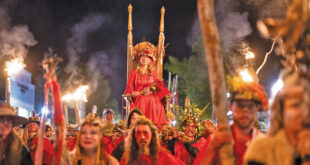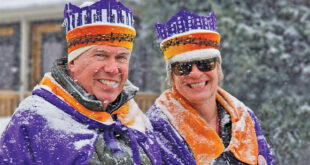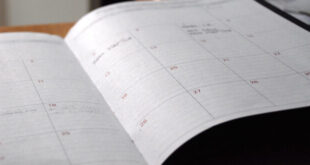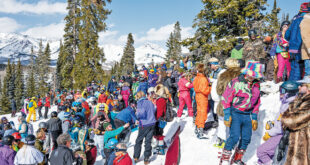It’s a pleasant, sunny dusty-day blur—but then endless hours of stringing beads into a matrix lace of necklaces and hammering silver and copper wire into dangling twisted earrings, all in a cloud of music, incense and other entrancing smoke, contributed fully to the natural state of haziness.
After all, 1972, my first year selling my amateur jewelry, was the year of harmonious flow—or at least one of the years of unstructured art fairs that began in 1971. Elk Avenue unplugged but tuned in to the needs of the people—the hippie artists and musicians somewhat newly relocated to town.
Today, the People’s Fair is the closest evolution of the original Arts Fair, with local and western slope regional artists selling very affordable creations in the two-day affair on Saturday, August 31 and Sunday, September 1. Jeff Dautrich, of the downtown Paragon Art Gallery, has been running the People’s Fair for eight years. Now in its 24th year, the event has grown to include 70 booths and fills Elk Avenue from 2nd to 4th Avenue.
The People’s Fair was organized by the Paragon Art Gallery to fulfill the need for local artists to showcase their work. Paragon is a collective co-op of artists pooling their time and creativity to run their own exhibit space on 2nd and Elk, downstairs in the Old Town Hall. This year’s fair is an eclectic mix of arts and crafts ranging from jewelry, soap, essential oils, fine art, leather works and more, to massage, food and music.
Two days of performances, hosted by Ridgway local and music slinger Kevin Marquis, will set the tone in acoustic blues and folk. Among the many regional musicians performing throughout the weekend is sorta local hero of foot tapping tunes, Bruce Hayes, who will also be around to do his thing.
Back this year because it was so well loved is the Live Birds of Prey from Nature Educators, who will be there with even more critters and more educators. These are birds that, although they’ve been rehabilitated, cannot be set free back into the wild for various reasons—their injuries were too great or they’ve bonded with humans—for whatever reason, they’re now used to educate people on bird conservation.
Back in the day, the original unpretentious 1970s Arts Fair, ancestor of the modern-day People’s Fair (and Festival of the Arts), was loosely manifested by three young men—Michael Berry, Jim Cazer and George Sibley.
“Michael had just purchased a semi-load of railroad ties at an auction,” Sibley said, explaining the origin and real motivation behind the first Arts Fair. “He thought that an interesting thing to do would be to build a covered pavilion that we could have an arts festival in to show off the art in the community. And he wanted to do something that the community could get into.”
So Berry set out to find Sibley, who was the editor and writer for the Chronicle newspaper at the time, to promote the idea and get the word out. It took about a week to build the pavilion—“This rambling, shaded but really nice, cool, lovely place that smelled of creosote but was a work of art itself,” Sibley remembers.
The pavilion went up between the old Frank and Gal’s saloon (about where the Eldo is) and the Grubstake (Brick Oven Pizza), where the post office parking lot is now. Berry had strong musical connections and got really fabulous musicians like Michael Martin Murphy before anyone knew who he was. Many local musicians played and there was much jamming, strumming and harmonizing. Several enduring and incredible things were born of the early Art Fairs—like the Mountain Theatre and the Totem Pole Park.
Susan Anderton, one of the original artists in town, recalls she “did a booth in the very first art fair in ‘71. We had a silk screen printing business called Empire Tunnel Graphics, named after an old mine, in the Company Store—original prints and posters of my work.” Back then, less planning and more free form was the norm. “It wasn’t like you had a formal committee that got together and decided to do something…it just happened. People just got together.” Susan laughs about the choice of using Army Tents in ’72: “It seemed sort of dark…it wasn’t the ideal situation. You had to creep into them.”
Back in the day, dogs were per capita as abundant as they are now, but without the leash law. “The dogs would urinate on my box of prints,” Susan says, as she fondly sifts through her recollections of the era. “People were so supportive and enthusiastic. I had some of the best times. I remember thinking I can’t believe I’m hearing all this great music in Crested Butte. We were young then, and so enthusiastic. It was magical.”
However in 1973, things changed. “Things got a bit rambunctious,” Sibley says, admitting that the third Arts Fair “was bigger than anyone wanted it to be.”
Then several artists with chain saws took four or five days to create the totem pole. Denny McNeil spearheaded the project along with Jim Cazar, Billy Folger and Barbara Sibley (George’s wife). “On Sunday afternoon we got a backhoe and stuck the totem pole in the ground.” The pole, restored in 2006, is still a standing tribute to the original fair in its location next to the creek, where it has stood for over three decades.
But the apparent turning point seemed to be the concert when a jam band named Jelly, which consisted of a lot of local musicians—and would-be musicians—playing original music started the crowd jumping with a chorus of vulgarity. “We had built a big bandstand in the town park. People started pouring in for that concert. The crowd was about the size of today’s Fourth of July crowd…The band had some of their own songs, which the crowd picked up on and they could be heard all the way to Gunnison,” Sibley says.
He was on the porch of then newly-former mayor Lyle McNeil, where the old timers were gathered, grumbling about the loudly chanted obscenities—and they didn’t like the sound of it. “It got out of hand. Although nothing really bad happened, people realized how bad it could have gotten.”
Consequently, there was no Art Fair in 1974 since no one wanted to take on the responsibility. But the following year it became a more standardized event. “It was more like the People’s Fair today,” Sibley says of 1975, and recalls the earlier fairs: “We weren’t into regulated juried events. There were more artists and it was very mellow and low key. Even though really good things came out of it—the theatre, the totem pole—it was clear it needed to decide what it needed to be when it grew up.”
The People’s Fair more resembles the original Arts Fair, without the drifting concepts and hippies, without the dust of Elk Avenue or Woodstock-like eruptions of youthful rantings. For Sibley, “It was quality not quantity. Art is for the people.”
And this year, the people can dally about listening to the free music or enjoy a massage, and fill up with some of the area’s delicious food from vendors like Josephine Kellett of Creative Catering, Gunnison’s own Lucky Dog with his natural hot dogs and all the trimmings, Jamie’s Jerky, Barb and Danny Meyers’ Kettle Corn, and Sherpa’s Cafe.
Jeff predicts that next year people should be on the watch for an Oh-Be-Dogful Rescue Dog Show, but this year he promises, “Interesting antiques, awesome arts and crafts and new vendors, and all sorts of cool stuff. The booths have been sold out for a couple months and the last two years have grown exponentially through word of mouth. This has become a fair that people want to be part of.”
For more information visit the website at paragonartgallery.com, and on Facebook as well. The 24th annual People’s Fair will take place on Elk Avenue from 10 a.m. to 5 p.m. on Saturday, August 31 and from 10 a.m. to 4 p.m. on Sunday, September 1.
 The Crested Butte News Serving the Gunnison Valley since 1999
The Crested Butte News Serving the Gunnison Valley since 1999




